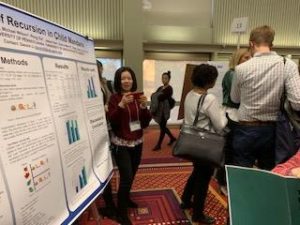Author Archives: Michael
Sundaresan colloquium Friday February 14 at 3:30
Bjorkman colloquium Tuesday February 11 at 4:00
This talk looks at interactions among linearization, prosody, and vocabulary insertion, focusing on cases of verb doubling that appear to be motivated not by syntactic movement, but by the need for an otherwise-unsupported clitic to have a host.
Drawing on examples of verb doubling in Ingush (Nakh-Dagestanian) and Breton (Celtic), I argue first that the linearization of syntactic structures is accomplished via the interaction of ranked and violable constraints, as in OT, rather than via a deterministic linearization algorithm of the type often assumed in syntax. Second, I argue that linearization and prosodification proceed in parallel, allowing verb doubling as a trade-off between prosodic well-formedness (the need of a clitic for a host) and optimal linearization—but that this evaluation occurs prior to both Vocabulary Insertion and the subsequent competition of segmental phonology.
The final sections of the talk discuss the implications of this model for doubling more generally, and more particularly for our ability to explain the fact that certain movement configurations appear to lead to doubling in some languages but not in others. I discuss verb doubling in predicate focus, clitic doubling, and several other instances of apparent multiple realization.
Happy Spring semester!
UMLAUT and the rest of the linguistics department are back from their winter hibernation.
Welcome back!
Charlow colloquium Friday December 6 at 3:30
Boston University Child Language Development Conference
At the BU Child Language Conference Nov8-10, there were posters and presentations by many students, visitors, and former students, and LARC members:
Bart Hollebrandse
Ana Perez, Rong Yin, Michael Wilson
Dulcie LI, Jessica Kotfila, Jennifer Spenader, Petra Schulz, Tom Roeper and Jill deVilliers,
on topics ranging from Quantification to Aspect to Recursion.
LAWNE Fall 2019
The Language Acquisition Workshop Northeast (Lawne) met for the first time at MIT on November 17th with presentations from Smith, MIT, UMass, and UConn. Jill deVilliers, Diego Lopez, Alex Santos, Joonkoo Park, and Tom Roeper gave four of the nine presentations.
Stanton colloquium Friday Nov 15 at 3:30
David Smith talk, Monday Nov 18
David Smith (https://www.khoury.northeastern.edu/people/david-smith/) will present “Textual Criticism as Language Modeling: Viral Texts, Networked Authors, and Computational Models of Information Propagation” at 4 pm Monday Nov. 18th in ILC N400. An abstract is below.
This presentation is to a joint meeting of the Initiative for Data Science in the Humanities, and the Data Science tea. If you have any questions, contact Joe Pater at pater@umass.edu. David will be available for half hour meetings from 1 – 3:30 in the Linguistics department – sign up here.
Abstract
The era of mass digitization seems to provide a mountain of source material for scholarship, but its foundations are constantly shifting. Selective archiving and digitization obscures data provenance, metadata fails to capture the presence of texts of mutable genres and uncertain authorship embedded within the archive, and automatic optical character recognition (OCR) transcripts contain word error rates above 30% for even eighteenth-century English. The condition of the mass-digitized text is thus closer to the manuscript sources of an edition than to a scholarly publication. On the computational side, models that treat collections as sets of independent documents fail to capture the processes by which new texts are generated from existing ones.
In this talk, I will discuss several aspects of our work on “speculative bibliography” with computational methods. Starting from a simple model of the composition of historical newspaper pages, with applications to text denoising, I describe models of how texts transform their sources, applied to modern science journalism, medieval Arabic historians, and the generically hybrid forms in nineteenth-century newspapers. I conclude by discussing methods for inferring network structure and mapping information propagation among texts and publications.
This is joint work with Ryan Cordell, Rui Dong, Ansel MacLaughlin, Abby Mullen, Ryan Muther, and Shaobin Xu.
German Network Grant
Leah Bauke, a former UMass Visitor, received a substantial German grant (DFG Network grant) for 7 European Scholars from Germany (Hopp, Wegner, Kupisch, Bauke), Austria (Rankin), Norway (Westergaard) and the US (Roeper) to study Optionality and Variation in Multilingual Syntax.


